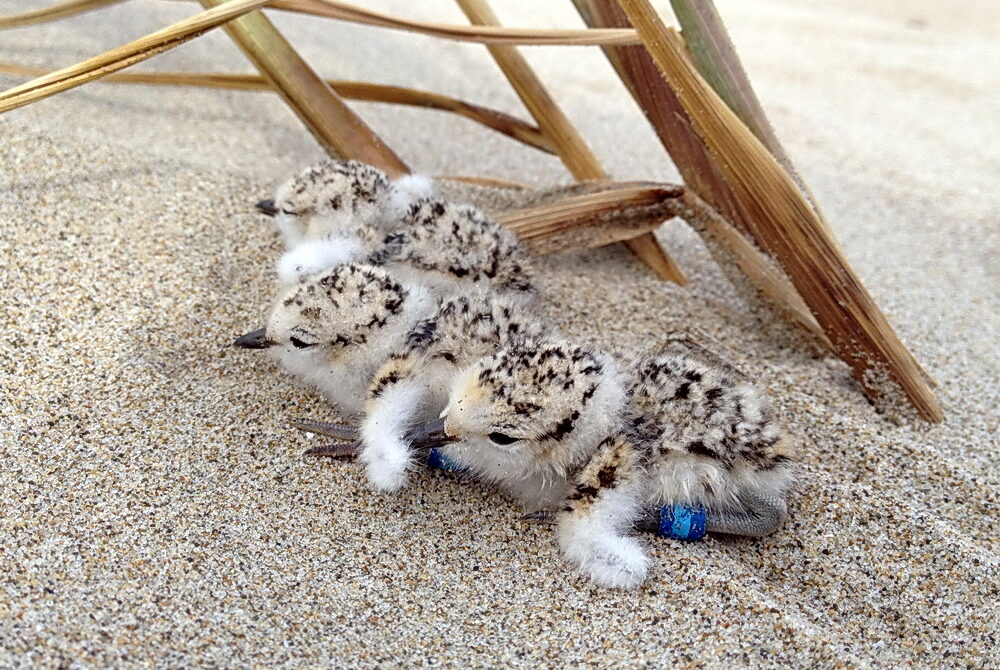Resources > News
Snowy Plover Nesting Period Ends


Beachgoers assist the ongoing effort to restore healthy populations of the threatened Western Snowy Plover to Oregon’s beaches by respecting nesting areas and beach restrictions during nesting season, March 15 through Sept. 15. Signs and ropes that identify sensitive western snowy plover nesting areas have gone up now that nesting season has begun, and all those who visit our shore will need to adhere to any posted restrictions.
The nesting period for 2018 is ended, opening up some areas of beach that were closed.
CoastWatchers have a special role to play in keeping an eye out for nesting plovers in unexpected areas not already protected, and watching for and reporting violations of protected nesting area restrictions. (Whether or not to reprove violators on the spot is a judgment call; under no circumstances get into an altercation—leave that to the State Police and Oregon Parks and Recreation Department beach rangers.) As extra incentive to watch closely for plovers in new nesting areas, note that plover nests have been spotted this year on the Clatsop Spit for the first time in decades, and that last year not only were plover nests observed on the Nehalem Spit, but one produced a successful hatchling. Where else might they start to appear?
These federally protected shorebirds nest on open sand along Oregon’s beaches. Nests, and especially chicks, are well-camouflaged. During nesting season, human disturbances can flush adult plovers away from their nests as they attempt to defend their young from the perceived predator. Left alone too long, eggs or chicks can die from exposure, predators, or human intrusion.
Restoration efforts have been succeeding, and the Snowy Plover population has been rebuilt to an extent, but this is still an active recovery effort and nest protection is essential to the bird’s survival and perhaps eventual delisting.
Certain beaches, listed here (Oregon dunes only) and here (coastwide), are known plover nesting areas. On these plover beaches, the dry sand and dunes are closed to all access, except along official trails, to protect eggs and chicks. Visitors may see roped off areas within these plover management areas, which serve to protect the most sensitive habitat; however, all dry sand on both sides of the rope is closed, except on designated trails. Wet sand areas on plover beaches remain open to foot and equestrian traffic (no dogs, kites, drones, camping, bicycles, or motor vehicles are allowed).
These plover nesting areas are spread along the entire coast and collectively comprise only about 40 miles of Oregon’s 362 miles of shoreline. “Visitors will have access to hundreds of miles of beaches without these seasonal restrictions,” said Laurel Hillmann, Ocean Shores Specialist for Oregon State Parks. “By planning your trip, you can enjoy the coast and help keep this sensitive bird safe.”
Visitors to the Oregon Dunes National Recreation Area are encouraged to review this map to identify unrestricted recreation areas, and information on riding motor vehicles on the sand can be found here.
Detailed information about nesting restrictions and site locations, as well as links to resources from Oregon State Parks, can be found on the Siuslaw website at www.fs.usda.gov/siuslaw.
The U.S. Fish and Wildlife Service listed Western Snowy Plovers as a threatened species in 1993. Habitat loss from invasive plants, as well as human disturbances, including litter and discarded food scraps that attract predators, have contributed to the birds’ decline. The Oregon Dunes Restoration Collaborative is working with land managers to develop and implement a restoration strategy as well as raise public awareness about the need to restore the dunes ecosystem for plovers, rare plants and animals, and the unique recreation opportunities offered by this landscape.
For more information, contact Lisa Romano, the Siuslaw National Forest’s public affairs staff officer, at (541) 750-7075, lmromano@fs.fed.us.
